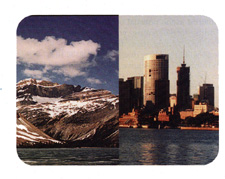

by Michael Loehr
This article originally appeared in
Videomaker Magazine on 01-Apr-96
(C)1998 Videomaker Magazine. Reproduction for uses other than personal is prohibited.
Those who read this column regularly may remember that a few months back, I told you about the different types of video edits and what they convey to the viewer. This month, I'll show you how to actually apply these transitions to make your videos more inviting and entertaining.
The best way to please an audience is to tell them a story. People would much rather watch a video that tells a story over one that just tells facts. Transitions are the editing tools that help you tell a story with video. Each transition sends the audience a unique subconscious message about what's happening on screen. By choosing an on-screen transition that supports what's happening in the story, you make the video easier for an audience to follow.
Some transitions effortlessly take viewers through a story one step at a time. Others can take them back in time for a story about a historic building, or take them across the globe to follow you on your vacation.
In the following pages, I've outlined some common video scenarios where transitions can improve how your video tells a story. You'll find at least a few of these situations familiar regardless of the kind of videos you make. You'll probably even run into some of them again in the future. The next time you do, try using one of these transition tricks.
Everybody With Me?
Before I launch into the different scenarios, let's make sure everyone's up to speed on
the different visual transitions available, and what you need to create them.
The cut is the simplest and most common editing transition. On screen, it appears as an instantaneous change from one shot to the next. It's visually the quickest way to get from one shot to another within a video. Technically, it's also the easiest to create. To make cuts, you simply need two VCRs capable of performing some type of video edit.
A fade gradually blends a video image into a colored background by slowly reducing the intensity of the image as the background fades in, or vice versa. To perform fades you need two VCRs, and a special effects generator (SEG) or switcher with a fader bar. Unlike the dissolve, which requires hardware capable of synchronizing two video sources, you can do fades with relatively simple and inexpensive SEGs.
Similar to a fade, a dissolve uses the same gradual blend to move from one video image to another, instead of to a colored background. Dissolves require that the two video sources be in perfect sync, so you must have a pair of time base correctors (TBCs) or an SEG with built-in frame synchronizer.
Instead of blending images, like the dissolve and fade, a wipe uses a moving geometric pattern to replace one image with another. Common wipe shapes are horizontal, vertical and diagonal lines, circles, squares and diamonds. The gear that performs a fade or dissolve will likely perform a wipe, too. If you want to wipe between one video source and a colored background, you'll need only one video source. To wipe between two video images, you'll need the same equipment setup as for a dissolve.

More like an entire family of transitions than just one specific type, the digital effect uses computer technology to create complex, highly specialized video transitions.
Some special effects generators that perform wipes and dissolves also include a handful of digital effects. These may include picture squeeze, zoom, freeze frame or mosaic.
As with wipes and dissolves, if you want to "effect" between two live video sources, you'll need two VCRs and a pair of TBCs or SEG with built-in frame sync.
In the Beginning
What better place to start using transitions to improve a video than the opening shot?
Many videos start with a one-second fade from a black background to the first shot. Early film editors borrowed this technique from theater, where lights coming up on the stage meant the beginning of an act in a play.
The technique works perfectly for starting a video as well. It gently tells the audience, "OK, here's the start of the show."
Just as transitions can improve how you kick off a video, they can also add an extra sense of closure to the finale. Nothing says, "The End" in a video like a fade to black.
If you want to mimic the feel of curtains opening or closing on your video, use vertical line or split-screen wipes. Producers of many early silent comedy films used circle wipes to add an extra dose of humor just before the end of a show. If your video has a comical mood, you might try one as well.
Sometimes you may not want to gently welcome the audience into your video. Instead, you'd rather startle them to attention.
If that's the case, use a cut from a black background to a dramatic opening shot to begin your video. Cutting straight from black makes viewers feel as though they walked in a bit late, or looked away just as the show began. That feeling makes them want to "catch up" with what's happening in the scene, which pulls them into your story that much quicker.
Trading Places
Transitions can help you take the audience to many different places in a video, without
making them seasick or asking them to pack a suitcase.
In a vacation video, you can take them along on your cab ride through downtown in rush hour, and then on your walk down the beach at sunset without showing all the hassles in-between.
A smooth way to get from one place to another in a video is with a dissolve. Slowly blending two images in a dissolve suggests that a relationship exists between them. The longer the dissolve, the more time the viewer has to ponder that relationship. The more time they spend thinking, the smoother the transition.
Wipes also work, but they communicate a change more deliberately than a dissolve. Dissolves tend to add "softness" to a transition, while wipes communicate activity, motion, life. As a transition between locations, wipes will work best if the video has a lighthearted approach, a sense of humor if you will.
Of course, to create a dissolve or a wipe in your video, you need some fairly expensive equipment at your fingertips. If you don't have that gear, cuts can get you from place to place equally well.
On screen, cuts will have a more abrupt appearance than a wipe or dissolve when changing locations. This change will probably startle your audience. You can make cuts work, however, if you use that abruptness as an asset.
Make the surprise work by cutting to a shot of something at the new location that will attract your viewers regardless of where it appears in the program. Show them something unusual, something interesting or funny, and you'll distract them from the abruptness of the cut. (Close-up shots work especially well.)
As their interest in the unusual object or activity drifts, they'll realize you've changed locations. Letting them figure out the change will help bring them into the story, and smooth out the move from one place to the next.
If you're able to perform fades with your editing system, you can quickly fade to black on one shot, and then up again on another to change locations. By waiting longer to fade up from black, you'll make the audience anticipate a more dramatic location change.
Time Travel
Videomakers who tell stories about historical subjects often need to bounce back and forth
between the "here and now," and how it was then. They need to illustrate the
movement of time, and explain the significance of how and why things changed. Different
transitions can help you move through time quite gracefully. (Too bad they can only let
you do it on videotape!)
As with moving from place to place, dissolves will take your viewers through time with the fewest side effects. They're the transition of choice if you want to take a sentimental journey through time.
In a historical video, you can dissolve between virtually any two scenes no matter how wide the time gap, and the audience will make the intellectual leap to follow along. You can dissolve from an old photo of a boy holding a toy baseball bat, to color video footage of him in his major league uniform, and your audience will fill in the details about what happened.
Wipes also work well in historical videos, particularly when you have a series of similar images of a subject.
If you have two or more historical photos of a landmark, like a building or city, using slow, soft-edge wipes to reveal each image can make the effects of time even more dramatic than a dissolve. It may be too dramatic an effect, however, to use for shots of people or faces.
Cuts can add a bit of life to still shots of old photos. You can imply a sense of activity or movement by cutting between different shots of the same photograph. Start with a wide shot of the entire photo, then cut to close-ups of people or objects within it. You might try using a slow zoom or pan in some of these shots as well.
Elastic Time
By changing how you pace your cuts, dissolves or wipes, you can affect how quickly time
appears to pass in a video.
Cutting quickly between various images will accelerate the perceived speed of whatever happens on screen. You can use this technique to make any scene feel hurried or rushed. By simply increasing the number of cuts you make in a given scene, you can make it appear to happen more quickly.
The action will seem to slow down if you put more space between cuts. Long shots, particularly of still or nearly still subjects, communicate a very tranquil, peaceful mood to a viewer.
In addition to softening a transition, dissolves tend to suspend time. The longer the dissolve between two images, the slower the perceived passage of time.
Wipes can manipulate the speed of time in a video, but they can also help indicate the direction of time. Wiping from one scene to another with a left-to-right vertical line communicates a move forward in time.
The speed of the wipe will imply how quickly, or how far forward, it moved. A quick wipe might say to the viewer, "Later that same day...," where a slow wipe might indicate a much longer gap. By wiping from right to left with a vertical wipe, you can enhance the feeling of moving backward in time.
Horizontal line wipes that travel from top-to-bottom, and wipe from video to a black screen or colored background, can imply a sunset. Moving from a black screen to video using a bottom-to-top wipe can imply a sunrise.
You can also use quick fades to and from black to indicate the passage of time. As with fades that indicate a location change, the longer you stay "in black," the longer the expected or assumed passage of time between scenes.
Special Effects
Thanks to modern technology, we have many dazzling video transitions just a finger's press
away. Granted, it takes a few dollars to get those effects within arm's reach. The fact
that we have access to such video technology, however, is truly amazing.
You may find yourself tempted to use these effects for many of your edits because they look cool, and attract attention much more than cuts, wipes and dissolves.
Beware of this urge. While special digital transitions do indeed dazzle the eye, many of them overpower the story in a video. Instead of helping guide the audience from one idea to another, some digital effects stomp their way into the story, make a statement, and then disappear. They don't imply a connection between two ideas, or support what's happening on screen. They simply look cool.
Looking cool isn't bad, but it won't necessarily help you tell a better story. Overusing digital or special effects can also make an audience dizzy, or confuse them about what's really happening in the video.
Stay focused on telling a story, and find places where digital tricks support it. Despite a sometimes over- the-top appearance, all digital effects have their time and place in telling stories.
If you want very abruptly stop time in your story, nothing does it more dramatically than a freeze frame. Seeing life literally freeze in space and time will immediately engage the audience.
If you want to take the viewer into a dream sequence, or show them someone's memory or imagination, combining a mosaic effect and a dissolve can communicate that quite well.
Standby to Fade
Remember that over 80 percent of the transitions in major motion pictures and television
programs are cuts. Producers of those shows choose cuts for one very good reason: they
work. Used properly, cuts could be the only transition you'll ever need.
Since many SEGs offer numerous simple, fun transitions, it's tempting to use them all. Fight the urge-- don't go overboard. Use cuts for every possible edit, unless you can find one of the other edits that clarifies the meaning, or feels more appropriate for the mood of the video. Your audience will thank you for it.
This article
originally appeared in
Videomaker Magazine April 1996.
Reprinted with permission from
Videomaker Magazine, Chico CA. Videomaker, Inc. All Rights Reserved.
Home Page | Assignments | Syllabus | Instructor | JMC Web Site